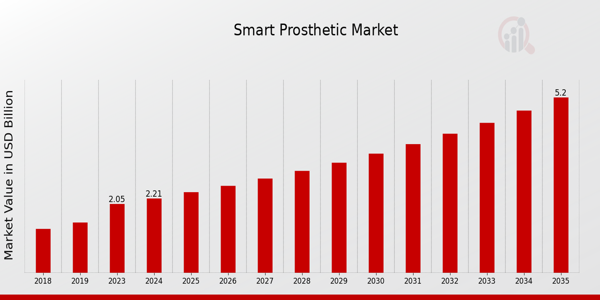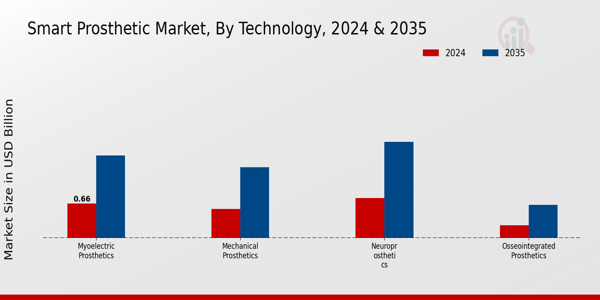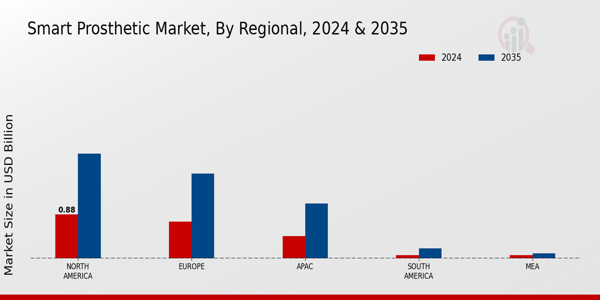Smart Prosthetic Market Overview
As per MRFR analysis, the Smart Prosthetic Market Size was estimated at 2.05 (USD Billion) in 2023.
The Smart Prosthetic Market is expected to grow from 2.21(USD Billion) in 2024 to 5.2 (USD Billion) by 2035. The Smart Prosthetic Market CAGR (growth rate) is expected to be around 8.08% during the forecast period (2025 - 2035).
Key Smart Prosthetic Market Trends Highlighted
The Smart Prosthetic Market is experiencing significant growth driven by advancements in technology, increasing demand for improved mobility solutions, and rising awareness regarding the benefits of smart prosthetics. Key market drivers include the integration of artificial intelligence and machine learning, which enhance the functionality and adaptability of prosthetic devices.
Additionally, the growing prevalence of diabetes and vascular diseases that lead to amputation contributes to a higher demand for these solutions as individuals seek a better quality of life through innovative rehabilitation options. There are ample opportunities to be explored in the areas of product innovation and personalization.With the ongoing development of more intuitive interfaces and user-friendly designs, manufacturers can appeal to a broader audience. There is also considerable potential in implantable devices and adaptive functionalities that can cater to the specific needs of users.
Developing regions represent a growing market for smart prosthetics, where accessibility and affordability can be enhanced through collaborative partnerships and local manufacturing initiatives. Recent market trends indicate a shift toward connected wellness, where prosthetics not only improve mobility but also enable health monitoring and data sharing. This trend aligns with the increasing consumer interest in smart health technologies and wearable devices.Moreover, mixed reality and augmented reality applications are beginning to influence the user experience, providing better training and rehabilitation support.
As healthcare systems evolve, there is a clear movement toward a more integrated approach, where smart prosthetics play an essential role in patient care and recovery. Stakeholders who stay ahead of these trends will likely achieve significant advantages in this dynamic market.

Source: Primary Research, Secondary Research, MRFR Database and Analyst Review
Smart Prosthetic Market Drivers
Technological Advancements in Prosthetics
The Global market of Smart Prosthetics is expected to expand in leaps and bounds as further advancements in the technology conducted in this area continue to grow. The introduction of artificial intelligence, robotics, and even 3D printing has completely transformed the construction and use of prosthetic devices. These technologies provide a better user experience through improved mobility, increased lifestyle adaptability, and higher customization of the devices to the user’s needs. For example, AI powered prosthetics can observe user behavior and adapt their movements in a more natural manner.
In addition, the use of advanced materials in the construction of prosthetics leads to lighter and more durable prosthetics, which ultimately leads to user comfort and satisfaction. As these technologies advance, they will not only improve the quality of life for the user and offset the impact of disability but will also broaden the demographic markets where smart prosthetics can be sold. The addition of smart and IoT features enables improved management and monitoring of health and actively expands the scope of the Smart Prosthetic Market. These aspects highlight the promising future of the industry over the next few years.
Increasing Incidences of Limb Loss
The Smart Prosthetic Market is driven by the increasing incidences of limb loss across the globe. This rise is often attributed to various factors, such as a growing number of diabetes cases, accidents, and conflicts. The need for effective rehabilitation solutions has escalated, leading to a higher demand for advanced prosthetic devices. Moreover, as awareness and acceptance of prosthetics improve among healthcare providers and patients alike, the market for smart prosthetics is expected to expand significantly.
Rising Geriatric Population
The Smart Prosthetic Market is significantly influenced by the rising geriatric population worldwide. As people age, there is a greater risk of mobility-related issues, which often result in the need for prosthetic solutions. This demographic is increasingly seeking technologies that enhance their quality of life and maintain their independence, thereby driving the demand for smart prosthetics. Innovative designs catering specifically to the needs of the elderly are expected to boost market growth.
Smart Prosthetic Market Segment Insights
Smart Prosthetic Market Technology Insights
The Smart Prosthetic Market is experiencing notable growth, with increasing technological advancements driving its expansion. By 2024, the market is expected to reach a valuation of 2.21 USD Billion, and this is projected to grow considerably in the following years. The technology segment is critical to this growth, as it includes multiple innovative domains that cater to various patient needs and enhance the functionality of prosthetic devices.
Key areas within this segment are Myoelectric Prosthetics, Mechanical Prosthetics, Neuroprosthetics, and Osseointegrated Prosthetics. Myoelectric Prosthetics, which are powered by electrical signals generated by muscle contractions, are expected to have a significant market valuation of 0.66 USD Billion in 2024 and a projected rise to 1.58 USD Billion by 2035, thus showcasing its growing importance in the industry, driven by increasing demand for more advanced prosthetic functions that improve users' mobility and control.Mechanical Prosthetics focuses on traditional yet effective solutions and is valued at 0.55 USD Billion in 2024, with its expected growth reaching 1.35 USD Billion by 2035. While less technologically advanced, they provide essential support where cost-effectiveness and simplicity are key factors for users.
Neuroprosthetics, valued at 0.76 USD Billion in 2024, taps into brain-machine interface technologies and is projected to reach 1.84 USD Billion by 2035, positioning itself as a promising frontier in enabling better integration between prosthetics and user neurology, which is crucial for enhancing overall user experience and satisfaction. Lastly, Osseointegrated Prosthetics, with a smaller valuation of 0.24 USD Billion in 2024 and an anticipated 0.63 USD Billion by 2035, involves innovative surgical and design techniques that enhance the attachment of prosthetics to the body, providing a stable and strong connection that is becoming increasingly valuable in rehabilitation contexts. The market trends in this segment are heavily influenced by technological advancements, personalized healthcare needs, and the increasing prevalence of limb loss due to various factors, including accidents and diseases.
Moreover, the Smart Prosthetic Market segmentation reveals an increasing focus on user-centric designs and improvements, where each category emphasizes increasing functionality, comfort, and adaptability to different lifestyles. The combination of these technologies aims to fulfill the evolving demands of the population requiring amputee solutions, resulting in continuous innovation and market growth. However, challenges remain in cost, accessibility, and standardization in technology, which can hinder broader adoption. The sustained investment in R, coupled with increasing incidences of limb loss, presents significant opportunities for all segments within the Smart Prosthetic Market to innovate and address these challenges, promising a progressive transformation in optimizing user quality of life in the upcoming years.

Source: Primary Research, Secondary Research, MRFR Database and Analyst Review
Smart Prosthetic Market Type Insights
The Smart Prosthetic Market exhibits significant growth driven by innovation and technological advancements, with a projected market value reaching 2.21 billion USD by 2024. This market is broadly segmented into Upper Limb Prosthetics, Lower Limb Prosthetics, and Orthotic Devices. Among these, Upper Limb Prosthetics plays a crucial role as it caters to the functional restoration of hand and arm mobility, addressing the needs of users for improved dexterity and usability. Lower Limb Prosthetics is significant as it facilitates mobility for individuals with leg amputations, enhancing their quality of life through advanced mobility solutions such as microprocessor-controlled devices.Additionally, Orthotic Devices support patients with musculoskeletal conditions and disabilities, reinforcing stability and aiding in rehabilitation processes.
Collectively, these segments contribute to the overall Smart Prosthetic Market revenue by addressing diverse healthcare demands and advancing patient care technology. The market is characterized by rising demand for personalized solutions, which spans across these categories, influenced by trends such as increased awareness of disability aids and growing healthcare investments to improve the quality of life for amputees and patients with mobility challenges.The competition is expected to intensify as manufacturers seek to innovate and capture market share, leading to new opportunities in product development and improved accessibility.
Smart Prosthetic Market End User Insights
The Smart Prosthetic Market has been showing substantial growth, expected to be valued at 2.21 billion USD by 2024. The End User segment of this market is critical, encompassing various facilities that utilize advanced prosthetic devices. Hospitals dominate this sector due to their advanced technological resources and the provision of comprehensive patient care, facilitating early intervention and effective rehabilitation.
Rehabilitation centers also play a significant role, focusing on physiotherapeutic treatments and patient management, which enhances patient outcomes and product adaptation.Furthermore, the Home Care segment is gaining traction, driven by the increasing demand for personalized health care and the rise in elderly populations preferring in-home support. This inclination towards at-home care solutions reflects a broader trend in the healthcare industry, emphasizing convenience and individual patient comfort in the rehabilitation process.
Insights drawn from the Smart Prosthetic Market data indicate that the growth within these segments is propelled by technological advancements, increased awareness, and the urgent need for improved quality of life through better prosthetic solutions.Therefore, analyzing the Smart Prosthetic Market segmentation reveals a nuanced landscape where hospitals, rehabilitation centers, and home care facilities each contribute uniquely to the evolving market dynamics.
Smart Prosthetic Market Material Insights
The Smart Prosthetic Market revenue is significantly influenced by the Material segment, which plays a crucial role in the overall performance and functionality of prosthetic devices. In 2024, the market for smart prosthetics is valued at 2.21 billion USD, reflecting a surge in demand for advanced materials that enhance comfort, durability, and user adaptability. Carbon fiber has emerged as a preferred choice due to its lightweight properties and high strength, enabling better mobility for users. Meanwhile, Titanium is recognized for its biocompatibility and robust structure, making it essential for durable prosthetic applications.Plastic remains widely accessible and cost-effective, contributing to the growing usability of smart prosthetics.
Additionally, Silicone is increasingly used for its flexibility and skin-like feel, providing comfort to users. Collectively, these materials address the diverse needs of patients, driving the growth of the Smart Prosthetic Market and presenting opportunities for further innovation in product development. The segmentation within the market shows significant diversity in applications, each contributing to the broader landscape of the Smart Prosthetic Market statistics.
Smart Prosthetic Market Regional Insights
The Smart Prosthetic Market exhibits a diverse regional landscape, with North America leading the charge, valued at 0.88 USD Billion in 2024 and projected to grow to 2.1 USD Billion by 2035, demonstrating a strong majority holding in the market. Europe follows closely, starting at 0.74 USD Billion in 2024 and reaching 1.7 USD Billion in 2035, indicating significant interest and development in smart prosthetics.
APAC region, valued at 0.45 USD Billion in 2024 and anticipated to grow to 1.1 USD Billion in 2035, reflects the increasing adoption of advanced technologies in rehabilitation.South America and the MEA region, while smaller in market size, starting at 0.07 USD Billion in 2024 and growing to 0.2 USD Billion and 0.1 USD Billion, respectively, by 2035, show potential growth opportunities as awareness expands. This segmentation of the Smart Prosthetic Market underscores distinct trends, with aging populations and rising incidences of limb loss driving demand, particularly in North America and Europe. Challenges such as healthcare accessibility in emerging economies and the high costs of advanced prosthetics can impact growth, yet they present opportunities for innovative solutions and improved market reach.

Source: Primary Research, Secondary Research, MRFR Database and Analyst Review
Smart Prosthetic Market Key Players and Competitive Insights
The Smart Prosthetic Market has witnessed significant advancements in technology, leading to the development of highly sophisticated and versatile prosthetic devices. This market is characterized by an array of players that are innovating and enhancing their product offerings to cater to the growing consumer demand for high-quality, functional, and adaptive prosthetics. Competitive insights into this market reveal that factors such as technological innovation, strategic collaborations, and mergers and acquisitions play a pivotal role in shaping the competitive landscape.
With emerging trends focusing on integrated technologies such as artificial intelligence and robotics, companies are increasingly investing in research and development to create more personalized and user-centric prosthetic solutions. Furthermore, the emphasis on improving patient outcomes and enhancing the quality of life continues to drive competition among leading firms.Apex Medical has positioned itself as a formidable player in the Smart Prosthetic Market, leveraging its strong research and development capabilities to advance its product line. The company has established a robust market presence due to its commitment to quality and innovation, which allows it to create prosthetic devices that are not only functional but also comfortable and user-friendly.
Apex Medical's strengths lie in its extensive experience in the healthcare sector, which has enabled it to build a reputation for reliability and dependability. The company's strategic partnerships and collaborations with healthcare professionals and researchers have enhanced its ability to design products that meet the unique needs of users, including the integration of smart technologies that improve user engagement and control.Open Bionics stands out in the Smart Prosthetic Market through its distinctive approach to the design and manufacturing of prosthetics. The company is known for its dedication to inclusive technology and making advanced prosthetic solutions more accessible to individuals regardless of age or socioeconomic status. Open Bionics has gained recognition for its innovative use of 3D printing technology, which allows for customizable and aesthetically appealing devices that can be tailored to the preferences of the user.
The company's strengths are rooted in its emphasis on community engagement and feedback, ensuring that the prosthetics not only meet functional requirements but also resonate with the users on a personal level. This focus on user-centric designs has garnered positive attention and support, creating a strong presence in the market with a commitment to improving the lives of amputees through cutting-edge solutions.
Key Companies in the Smart Prosthetic Market Include
- Apex Medical
- Open Bionics
- Advanced Arm Dynamics
- Blatchford
- Hanger Inc.
- Endolite
- Ottobock
- DePuy Synthes
- CURE International
- Smith and Nephew
- Freedom Innovations
- Zimmer Biomet
- Stryker
- Steeper Group
- Medtronic
Smart Prosthetic Market Developments
The Smart Prosthetic Market has recently witnessed significant developments, particularly in the area of technological advancements and market growth. Companies like Open Bionics are innovating with 3D-printed prosthetics, aiming to enhance accessibility and affordability for users. Apex Medical and Advantaged Arm Dynamics are also pushing boundaries by integrating AI and machine learning into prosthetic designs, facilitating improved functionality and user experience. In terms of mergers and acquisitions, Hanger Inc. has expanded its portfolio by acquiring a smaller prosthetics firm, which is expected to strengthen its market position significantly.
Ottobock continues to see growth, responding to increased consumer demand for high-quality prosthetic limbs, while Medtronic is focusing on enhancing its smart prosthetic offerings through strategic partnerships. Smith Nephew and Zimmer Biomet are investing in research to further develop hybrid prosthetics that combine robotic and traditional elements. The overall market valuation is trending upwards, driven by increasing awareness and technological advancements that are reshaping the industry, allowing for more personalized and efficient solutions for individuals with limb loss. Companies are thus positioned to capitalize on emerging opportunities, contributing to a dynamic market landscape.
Smart Prosthetic Market Segmentation Insights
Smart Prosthetic Market Technology Outlook
- Myoelectric Prosthetics
- Mechanical Prosthetics
- Neuroprosthetics
- Osseointegrated Prosthetics
Smart Prosthetic Market Type Outlook
- Upper Limb Prosthetics
- Lower Limb Prosthetics
- Orthotic Devices
Smart Prosthetic Market End User Outlook
-
- Hospitals
- Rehabilitation Centers
- Home Care
Smart Prosthetic Market Material Outlook
-
- Carbon Fiber
- Titanium
- Plastic
- Silicone
Smart Prosthetic Market Regional Outlook
-
- North America
- Europe
- South America
- Asia Pacific
- Middle East and Africa
| Attribute/Metric Source: |
Details |
| MARKET SIZE 2023 |
2.05(USD Billion) |
| MARKET SIZE 2024 |
2.21(USD Billion) |
| MARKET SIZE 2035 |
5.2(USD Billion) |
| COMPOUND ANNUAL GROWTH RATE (CAGR) |
8.08% (2025 - 2035) |
| REPORT COVERAGE |
Revenue Forecast, Competitive Landscape, Growth Factors, and Trends |
| BASE YEAR |
2024 |
| MARKET FORECAST PERIOD |
2025 - 2035 |
| HISTORICAL DATA |
2019 - 2024 |
| MARKET FORECAST UNITS |
USD Billion |
| KEY COMPANIES PROFILED |
Apex Medical, Open Bionics, Advanced Arm Dynamics, Blatchford, Hanger Inc., Endolite, Ottobock, DePuy Synthes, CURE International, Smith and Nephew, Freedom Innovations, Zimmer Biomet, Stryker, Steeper Group, Medtronic |
| SEGMENTS COVERED |
Technology, Type, End User, Material, Regional |
| KEY MARKET OPPORTUNITIES |
Rising aging population needs, Increased R&D investment in prosthetics, Growth in diabetic population, Advancements in AI and robotics, Expanding telehealth services for rehabilitation |
| KEY MARKET DYNAMICS |
Technological advancements in materials, Increasing prevalence of limb disabilities, Rising investment in healthcare innovations, Growing demand for personalized solutions, Expanding aging population and longevity |
| COUNTRIES COVERED |
North America, Europe, APAC, South America, MEA |
Frequently Asked Questions (FAQ) :
The Global Smart Prosthetic Market is expected to be valued at 2.21 USD billion in 2024.
By 2035, the Global Smart Prosthetic Market is anticipated to reach a value of 5.2 USD billion.
The projected CAGR for the Global Smart Prosthetic Market from 2025 to 2035 is 8.08%.
North America is expected to hold the largest market share, valued at 0.88 USD billion in 2024.
The market size for Neuroprosthetics technology is expected to reach 1.84 USD billion by 2035.
Key players in the Global Smart Prosthetic Market include Apex Medical, Open Bionics, and Ottobock, among others.
The Smart Prosthetic Market in Europe is expected to grow from 0.74 USD billion in 2024 to 1.7 USD billion by 2035.
Mechanical Prosthetics are projected to be valued at 0.55 USD billion in 2024 and 1.35 USD billion in 2035.
Emerging trends include advancements in myoelectric and neuroprosthetics technologies driving market growth.
The expected market size for Osseointegrated Prosthetics by 2035 is 0.63 USD billion.

















